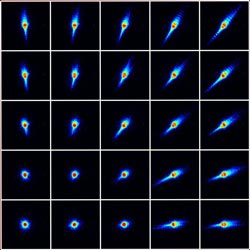Super-Resolution X-ray Microscopy unveils the buried secrets of the nanoworld

Diffraction picture:Twenty-five out of typically ten-thousand coherent x-ray diffraction images used for reconstructing one single super-resolution x-ray micrograph.
The first super-resolution images from this novel microscope will be published online July 18, 2008 in the journal Science.
“Researchers have been working on such super-resolution microscopy concepts for electrons and x-rays for many years,” says EPFL Professor and team leader Franz Pfeiffer. “Only the construction of a dedicated multi-million Swiss-franc instrument at PSI's Swiss Light Source allowed us to achieve the stability that is necessary to implement our novel method in practice.”
The new instrument uses a Megapixel Pilatus detector (whose big brother will be detecting collisions from CERN's Large Hadron Collider), which has excited the synchrotron community for its ability to count millions of single x-ray photons over a large area. This key feature makes it possible to record detailed diffraction patterns while the sample is raster-scanned through the focal spot of the beam. In contrast, conventional x-ray (or electron) scanning microscopes measure only the total transmitted intensity.
These diffraction data are then treated with an algorithm conceived by the Swiss team. “We developed an image reconstruction algorithm that deals with the several tens of thousands of diffraction images and combines them into one super-resolution x-ray micrograph,” explains PSI researcher Pierre Thibault, first author on the publication. “In order to achieve images of the highest precision, the algorithm not only reconstruct the sample but also the exact shape of the light probe resulting from the x-ray beam.”
Conventional electron scanning microscopes can provide high-resolution images, but usually only for the surface of the specimen, and the samples must be kept in vacuum. The Swiss team's new super-resolution microscope bypasses these requirements, meaning that scientists will now be able to look deeply into semiconductors or biological samples without altering them.
It can be used to non-destructively characterize nanometer defects in buried semiconductor devices and to help improve the production and performance of future semiconductor devices with sub-hundred-nanometer features. A further very promising application of the technique is in high-resolution life science microscopy, where the penetration power of X-rays can be used to investigate embedded cells or sub-cellular structures. Finally, the approach can also be transferred to electron or visible laser light, and help in the design of new and better light and electron microscopes.
Media Contact
More Information:
http://www.psi.chAll latest news from the category: Physics and Astronomy
This area deals with the fundamental laws and building blocks of nature and how they interact, the properties and the behavior of matter, and research into space and time and their structures.
innovations-report provides in-depth reports and articles on subjects such as astrophysics, laser technologies, nuclear, quantum, particle and solid-state physics, nanotechnologies, planetary research and findings (Mars, Venus) and developments related to the Hubble Telescope.
Newest articles

Superradiant atoms could push the boundaries of how precisely time can be measured
Superradiant atoms can help us measure time more precisely than ever. In a new study, researchers from the University of Copenhagen present a new method for measuring the time interval,…

Ion thermoelectric conversion devices for near room temperature
The electrode sheet of the thermoelectric device consists of ionic hydrogel, which is sandwiched between the electrodes to form, and the Prussian blue on the electrode undergoes a redox reaction…

Zap Energy achieves 37-million-degree temperatures in a compact device
New publication reports record electron temperatures for a small-scale, sheared-flow-stabilized Z-pinch fusion device. In the nine decades since humans first produced fusion reactions, only a few fusion technologies have demonstrated…





















